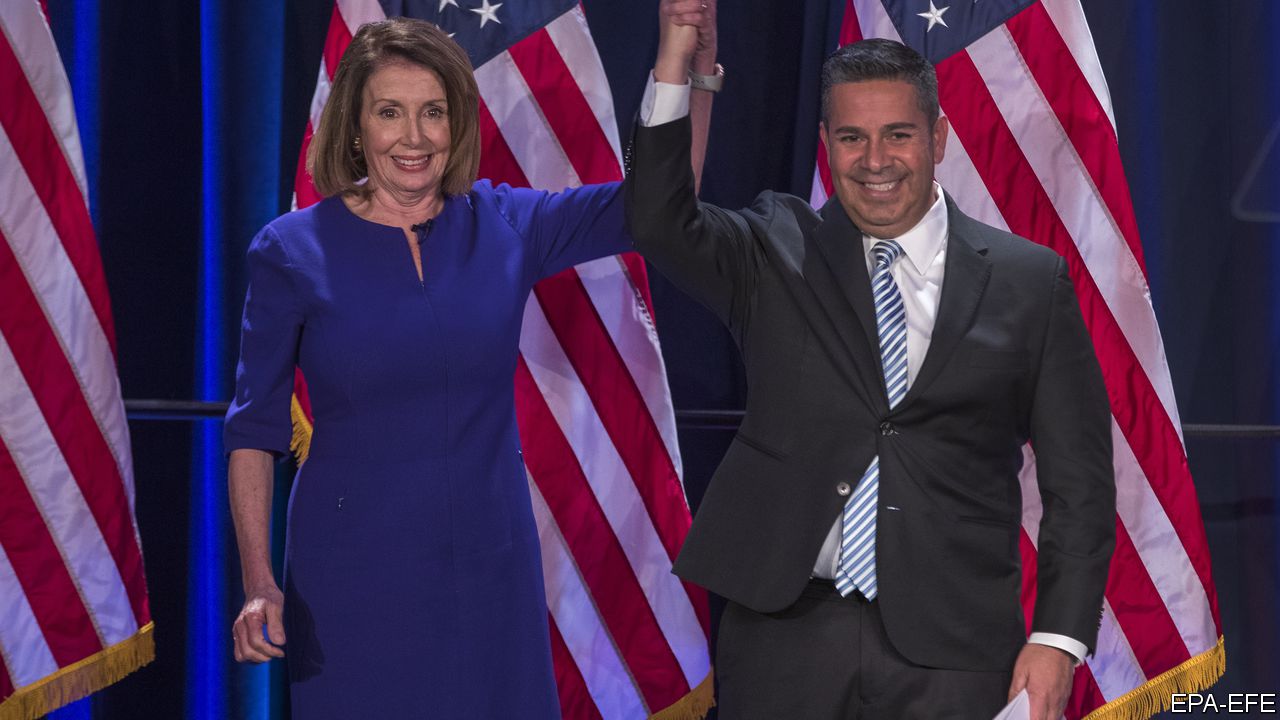
AFTER TWO years of unified Republican control, divided government is returning to Washington. In arguably the most consequential mid-term elections in recent memory, the Democratic Party won a comfortable majority in America’s House of Representatives. Although the exact tallies have not yet been finalised, the Democrats needed 218 seats to wrest back the speakership, and are expected to end up with around 230. Their victory puts an end to President Donald Trump’s hopes of enacting further conservative legislation during the second half of his term. It also sets the stage for a whirlwind of Congressional investigations into Mr Trump’s business dealings, his cabinet’s management of federal agencies and alleged collusion between his presidential-campaign staff and Russian operatives. The Democratic majority could also initiate impeachment proceedings against Mr Trump, although that would be unwise given that the Senate would not follow suit. Nancy Pelosi (pictured left), the party’s leader in the lower house, has ruled out an effort to impeach the president for now.
On the other side of the Capitol, it was the Republicans who were cheering, as they will expand their current 51-49 majority in the Senate by anywhere from two to four seats. The mix of Senate contests this year strongly favoured the party: of the 35 seats up for election, just nine were held by Republicans, and five incumbent Democrats were on the ballot in states Mr Trump won by double digits in 2016. Still, the Democrats hoped that their large advantage in overall popularity this year might enable these vulnerable senators to hold on, and polls suggested that only one of them faced a clear deficit.
In the end, however, there was too much Republican DNA in many of these states for Democratic candidates to overcome. Heidi Heitkamp of Nevada, Joe Donnelly of Indiana and Claire McCaskill of Missouri were all defeated. Florida also continued to favour Republicans, as Rick Scott, the current Republican governor, beat the incumbent Bill Nelson by less than one percentage point. With extra breathing room in the Senate, Mr Trump will probably be able to win confirmation of his nominees if he decides to replace members of his cabinet, or if another Supreme Court seat becomes vacant. The Republican victories will also make it extremely difficult for the Democrats to retake the Senate in 2020, leaving them with little hope of implementing campaign promises even if they were to win back the presidency.
In close races for state governors, the elections rendered a split decision. Democrats were disappointed in Florida and Georgia, where the party nominated overtly progressive black candidates to run against populist, white conservatives whom Mr Trump backed in the Republican primaries. The Florida race has already been called for the Republican, and in Georgia, the Republican candidate has 51% of the vote. However, the Democrats did claim a prize scalp in Wisconsin, where a batch of late-counted absentee ballots put the two-term incumbent Scott Walker at a one-percentage-point disadvantage. They also defeated Kris Kobach, an anti-immigration hard-liner close to Mr Trump, in deep-red Kansas, and won the governorship of Nevada. And by larger margins, they picked up the governors’ mansions in Michigan, New Mexico and Maine. Combined with their gains in state legislatures, the Democrats added “trifectas”—meaning control of the governorship and both chambers of the legislature—in New York, Illinois, New Mexico, Colorado, Maine and Nevada, and ended Republican ones in Michigan, New Hampshire, Kansas and Wisconsin.
Beyond the achievement of recapturing the House, the best news for Democrats was probably the results in state-level ballot initiatives. Missouri, Michigan and Colorado approved referenda delegating the drawing of legislative districts to non-partisan commissions, and voters in Florida met the 60% threshold to pass an initiative that restored the right to vote for felons who have completed their prison sentences. Idaho and Nebraska also voted to participate in the expansion of Medicaid, the federal health-care programme for people under 65, that was a centrepiece of former President Barack Obama’s health-care reform. Montana and Utah may do so as well.
Democrats have been eagerly anticipating this year’s midterms since the day they lost the presidential election of 2016. When compared with the sweeping victories for the opposition party in 2006, 2010 and 2014, the party’s loss of Senate seats and defeats in a few tight gubernatorial races may leave its loyalists feeling disappointed. However, a year ago betting markets only gave the opposition a 50/50 chance of re-taking the lower chamber. The Democrats’ share of all votes cast for the House is expected to be as large or larger than in previous wave elections. The Republican monopoly on federal power is about to end, and Congressional oversight of the executive branch will return with a vengeance.
See also:
2018 mid-term elections results








